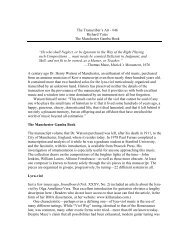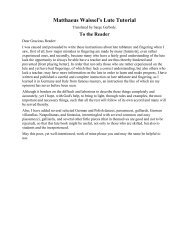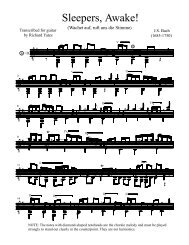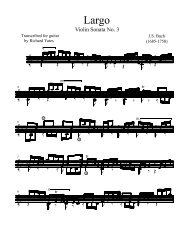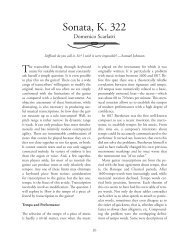Article38-Beach - Richard Yates Classical Guitar Transcriptions
Article38-Beach - Richard Yates Classical Guitar Transcriptions
Article38-Beach - Richard Yates Classical Guitar Transcriptions
You also want an ePaper? Increase the reach of your titles
YUMPU automatically turns print PDFs into web optimized ePapers that Google loves.
The Transcriber’s Art - #38<br />
<strong>Richard</strong> <strong>Yates</strong><br />
Secrets and Minuet, by Amy <strong>Beach</strong><br />
Study how best to develop all the possibilities of a small form. A small gem may be just as<br />
brilliantly cut as one weighing many carats —Amy <strong>Beach</strong>, “Music’s Ten Commandments as<br />
Given for Young Composers”<br />
Earlier articles in this series promoted the search for transcription material in keyboard works<br />
composed as teaching tools or specifically for children. That strategy has again proven its value<br />
although I have changed the lesson a bit to fit the guitar.<br />
Amy <strong>Beach</strong><br />
The stories told of Amy <strong>Beach</strong>’s early years show that she deserves equal standing with such<br />
musical prodigies as Mozart and Chopin. At just one year of age she could sing 40 melodies<br />
from memory and with perfect pitch. She composed piano pieces at age four, and—strikingly<br />
reminiscent of a Mozart legend—could accurately remember four-part vocal music after one<br />
hearing. At age seven she began public piano recitals of Handel, Beethoven and Chopin, as<br />
well as her own pieces. Although she was discouraged from public performance and from<br />
studying composition by her parents and later by her husband, she eventually excelled at both<br />
and enjoyed a long career of piano concerts and acclaimed compositions. Most of her music<br />
was published under the name “Mrs. H.H.A. <strong>Beach</strong>”, but following her husband’s death in<br />
1910 she changed it to “Amy <strong>Beach</strong>”. However, she found that her reputation was so strongly<br />
tied to “Mrs. H.H.A. <strong>Beach</strong>” that she resumed it several years later for her published music.<br />
The catalog of her music is substantial and varied: music for keyboard, chamber ensembles,<br />
orchestra, secular and sacred chorus, and songs. She was at ease with the largest groups as<br />
shown in her Mass in E Flat, Op. 5 and the ‘Gaelic’ Symphony, Op. 3, but it is her skill with<br />
small keyboard forms that guitarists can best appreciate. Children’s Carnival, Op. 25 and<br />
Children’s Album, Op. 36 (written the same year as the Symphony) both are sources of<br />
material well-suited to the guitar. The history of music shows that only the best composers<br />
have this ability to combine instruction and beauty in small forms.<br />
Secrets, Op. 25, No. 5<br />
The scope of her musical activities precluded an extensive teaching career, but <strong>Beach</strong> was<br />
always supportive of musical clubs and music education. She composed several dozen pieces<br />
for children that are deftly scaled for smaller hands and that incorporate specific technical<br />
lessons. The piano score of Secrets is marked la melodia molto tenuto meaning “hold the<br />
melody notes for their full duration.” It might not be immediately obvious to readers which<br />
notes these are, but examination of the original gives some clues about her intent (see Figure<br />
1).
#<br />
& # c<br />
Œ<br />
œ<br />
œ Œ œ<br />
#<br />
& # c<br />
œ Œ<br />
œ Œ<br />
œ œ<br />
Figure 1<br />
The entire piece uses this texture except for the couple of measures of scale melody. The first<br />
of each pair of beamed eighth notes has a quarter note stem showing that it is to be held<br />
(‘tenuto’) through the end of the following eighth note when they are then both released. The<br />
left and right hands alternate in this fashion. The quarter-stemmed notes do not by themselves<br />
form a melody, so the teaching purpose of the piece seems to be to train the basic keyboard<br />
motion of holding down a note while then playing another one with a finger of the same hand.<br />
Although the mechanics of doing this on the piano are unlike those of the guitar, there certainly<br />
are technical issues related to note duration that are necessary for guitarists to master. While<br />
our errors are often in the opposite direction—allowing notes to ring over too long (‘troppo<br />
tenuto’?)—we also must learn how to maintain them just as <strong>Beach</strong> is trying to teach.<br />
Transcribers can collude in these errors or help correct them through the fingerings that they<br />
choose.<br />
The over-ringing of notes in arpeggio textures is an idiomatic feature of guitar music that<br />
can be supported through fingering choices and I have attempted to do this throughout the<br />
transcription of Secrets. The standard that I tried to meet was to have every arpeggio note<br />
fingered so that it could he held past the start of the next note. This accounts for the<br />
occasionally arcane fingerings that you see in the score and the plethora of fingering numbers<br />
(‘troppo notazione’!?). There are places where this standard simply could not be maintained,<br />
but still I may have pushed the limits beyond what is reasonable or feasible for some players.<br />
For those readers who find my little exercise excessive or frustrating, and who are getting a<br />
little dizzy from all of the white-out they are slathering on the score, I have posted a file of<br />
Secrets entirely without fingering on my website at www.yatesguitar.com/secrets.pdf.<br />
Minuet, Op. 36, No. 1<br />
The Minuet is the first of five pieces in Children’s Album, Op. 36 all of which are suitable for<br />
guitar transcription. It combines grace, elegance and delicate harmonic sense within a small<br />
form. The piano score is contained on two treble staffs and a range of barely two octaves.<br />
Transposed from F major to G major in the guitar transcription, it sits entirely on the first five<br />
strings and required no unusual modifications. Because the sixth string is not used, it could fit<br />
comfortably into a recital program before a piece that uses drop D tuning—just tune the sixth<br />
string down before the Minuet and it will have settled into that pitch well before you need it.<br />
If you have alternate strategies for transcribing these pieces, please get in touch through:<br />
<strong>Richard</strong> <strong>Yates</strong><br />
richard@yatesguitar.com<br />
http://www.yatesguitar.com<br />
œ
Transcribed for guitar<br />
by <strong>Richard</strong> <strong>Yates</strong><br />
5<br />
V #<br />
Minuet<br />
Op. 36, No. 1<br />
V # .<br />
.<br />
4 3<br />
4 œ œ œ 1œ œ<br />
1<br />
2˙.<br />
œ œ œ 4 œ<br />
4<br />
p<br />
.<br />
œ œ V œ # -2<br />
œ œ œ œ œ<br />
œ -3œ # . n<br />
œ<br />
.<br />
3 œ ˙. b ˙.<br />
3œ<br />
2<br />
˙<br />
3<br />
4<br />
œ<br />
˙.<br />
Amy <strong>Beach</strong><br />
(1867–1944)<br />
œ œ œ<br />
œ œ œ œ œ<br />
Œ<br />
9<br />
V #<br />
. V œ<br />
œ œ œ œ<br />
œ œ œ œ<br />
˙ .<br />
œ œ œ<br />
œ<br />
œ œ œ œ œ<br />
˙.<br />
13<br />
V # œ . œ . .<br />
# œ œ<br />
œ<br />
18<br />
V #<br />
œ<br />
˙<br />
˙ -23<br />
œ œ<br />
2<br />
3<br />
œ˙<br />
.<br />
œ<br />
˙<br />
œ œ œ<br />
.<br />
œ<br />
.<br />
œ<br />
Œ<br />
# œ œ œ 1#<br />
œ ˙ œF ˙.<br />
œ<br />
˙<br />
˙<br />
œ œ<br />
4<br />
œ œ œ œ<br />
˙.<br />
cresc.<br />
œ<br />
œ œ<br />
4<br />
3<br />
.<br />
.<br />
œ<br />
.<br />
œ<br />
Œ<br />
nœ<br />
˙<br />
p<br />
œ<br />
˙.<br />
œ œ 23<br />
V #<br />
27<br />
V #<br />
œ˙.<br />
œ œ œ<br />
˙.<br />
# œ<br />
œ œ œ<br />
œ œ<br />
œ<br />
Œ Œ<br />
œ œ œ œ œ œ<br />
˙œ œ œ œ<br />
.<br />
œ<br />
˙<br />
˙<br />
b˙<br />
œ œ œ<br />
˙.<br />
F<br />
.<br />
œ<br />
œ b˙<br />
˙<br />
b˙<br />
œ œ<br />
œ<br />
œ.<br />
23 ˙<br />
J œ œ œ<br />
‰ j œ # œ<br />
.<br />
n˙<br />
œ
32<br />
V # 4 œ<br />
3 n<br />
2<br />
˙<br />
f<br />
37<br />
V #<br />
# œ œ œ<br />
œ œ œ œ<br />
rit.<br />
œ<br />
œ<br />
œ œ<br />
p<br />
œ a tempo<br />
œ V œ œ<br />
# .<br />
˙.<br />
œ<br />
˙.<br />
œ œ œ<br />
œ<br />
œ œ œ<br />
n .<br />
b ˙.<br />
œ<br />
˙.<br />
œ œ œ<br />
œ œ œ œ œ œ<br />
˙ Œ<br />
41<br />
V #<br />
V<br />
4 œ œ<br />
œ œ œ 1œ œ œ œ<br />
˙ 2<br />
.<br />
œ œ œ<br />
œ<br />
œ œ œ œ œ<br />
˙.<br />
2<br />
III<br />
œ<br />
n˙<br />
œ<br />
œ<br />
œ<br />
46<br />
V # œ<br />
Fine 4<br />
œ œ œ<br />
˙ bœ<br />
œ ˙<br />
. .<br />
œ nœ<br />
œ<br />
˙. ˙ œ œ œ œ œ œ<br />
2<br />
cresc. f<br />
p<br />
50<br />
V #<br />
˙<br />
3˙<br />
Œ nœ 0 œ œœ<br />
˙<br />
4<br />
Œ œ œ Œ œ œ œ œ œ ˙ œ<br />
54<br />
V #<br />
nœ<br />
œ œ ˙ œ<br />
V 4<br />
œ<br />
˙<br />
œ<br />
œ 1˙<br />
# 4 3<br />
œ œ n<br />
œ<br />
œ œ œ œ œ<br />
˙ œ<br />
cresc.<br />
58<br />
V #<br />
2<br />
˙<br />
Œ<br />
nœ<br />
œ<br />
n˙<br />
Œ<br />
bœ<br />
œ<br />
œ<br />
˙<br />
nœ<br />
œ œ<br />
Œ<br />
œ<br />
Œ<br />
dolce<br />
œ nœ<br />
œ<br />
V # 1<br />
62<br />
3<br />
nœ<br />
œ<br />
Πn<br />
œ œ j<br />
.<br />
œ œ nœ œ œ<br />
œ. 1œ 2œ<br />
œ<br />
˙ Œ<br />
π<br />
2<br />
œ.<br />
˙<br />
D.C.<br />
j<br />
œ œ œ<br />
Œ
Transcribed for guitar<br />
by <strong>Richard</strong> <strong>Yates</strong><br />
Andantino<br />
la melodia molto tenuto<br />
II 3<br />
V # # c<br />
4<br />
œ<br />
p<br />
œ œ œ œ<br />
3<br />
œ<br />
Secrets<br />
Op. 25, No. 5<br />
4<br />
œ œ œ<br />
0<br />
0<br />
œ<br />
0<br />
œ<br />
4<br />
3<br />
œ<br />
3œ1œ<br />
2œ<br />
œ<br />
4<br />
5<br />
3œ<br />
2œ<br />
1œ<br />
Amy <strong>Beach</strong><br />
(1867–1944)<br />
œ<br />
VII<br />
œ<br />
œ œ<br />
3œ<br />
4<br />
V # #<br />
5<br />
2œ<br />
1œ 3œ 4œ<br />
1œ<br />
3œ<br />
œ<br />
2<br />
œ 4<br />
œ 4 œ<br />
4œ<br />
2œ<br />
1 œ<br />
3<br />
3<br />
2œ<br />
œ 1 œ<br />
1œ<br />
œ œ 0<br />
œ œ œ œ 4# œ<br />
4<br />
7<br />
V # #<br />
6<br />
3œ<br />
œ<br />
1<br />
œ 4 œ 0<br />
VI<br />
œ 2<br />
3#œ<br />
IV<br />
œ # œ<br />
œ<br />
2<br />
œ œ 4<br />
œ nœ<br />
œ<br />
œ nœ<br />
II 3<br />
4<br />
œ œ œ œ œ œ œ œ<br />
10<br />
V # #<br />
œ œ œ œ<br />
3œ<br />
œ œ œ 5<br />
2œ<br />
1œ<br />
3œ<br />
œ<br />
2<br />
VII<br />
nœ<br />
œ œ œ<br />
5<br />
3<br />
œ<br />
œ 4<br />
œ œ<br />
2# œ<br />
3œ<br />
œ nœ<br />
13<br />
V # #<br />
0nœ<br />
œ<br />
3<br />
5<br />
5<br />
œ<br />
4#<br />
œ<br />
2 œ<br />
1œ<br />
œ nœ<br />
œ œ œ œ œ<br />
3 œ<br />
2<br />
1œ<br />
4<br />
œ<br />
1 œ 0œ<br />
dim.<br />
œ 3<br />
œ<br />
2 œ # œ œ œ
16<br />
V # #<br />
œ œ œ<br />
.<br />
œ œ œ œ œ<br />
œ<br />
4 œ œ<br />
œ<br />
3<br />
π<br />
dolce<br />
II 3<br />
œ œ œ œ<br />
3œ<br />
4œ<br />
1 œ<br />
œ<br />
œ œ œ œ<br />
19<br />
V # #<br />
II<br />
œ œ œ œ 3<br />
œ œ œ œ<br />
4œ<br />
œ œ œ œ<br />
cresc.<br />
œ œ œ<br />
4œ 3œ<br />
œ 1 œ<br />
2<br />
œ # œ<br />
œ œ 4<br />
22<br />
V # #<br />
III 2<br />
œ<br />
f<br />
œ œ œ œ œ œ œ<br />
3<br />
œ 2 œ 4 œ œ œ œ œ œ<br />
b œ<br />
œ œ œ œ<br />
œ œ œ<br />
poco rit.<br />
25<br />
V # #<br />
II 2<br />
VII<br />
œ œ œ œ œ œ œ œ œ œ œ œ œ œ œ œ œ œ œ œ œ<br />
π a tempo<br />
œ œ œ<br />
28<br />
V # #<br />
œ œ œ œ œ œ œ œ<br />
4œ<br />
1<br />
œ<br />
œ 2œ<br />
2 œ œ nœ<br />
3<br />
la seconda volta molto rit.<br />
œ<br />
1œ<br />
œ 4<br />
œ œ<br />
œ œ bœ<br />
œ<br />
31<br />
V # 1<br />
# . .<br />
œ œ œ œ<br />
1 4 œ<br />
3œ<br />
œ œ ‰ œ œ œ œ 2<br />
œ œ ‰<br />
. Œ œ œ œ ˙π<br />
œ Œ<br />
.<br />
Œ ˙π


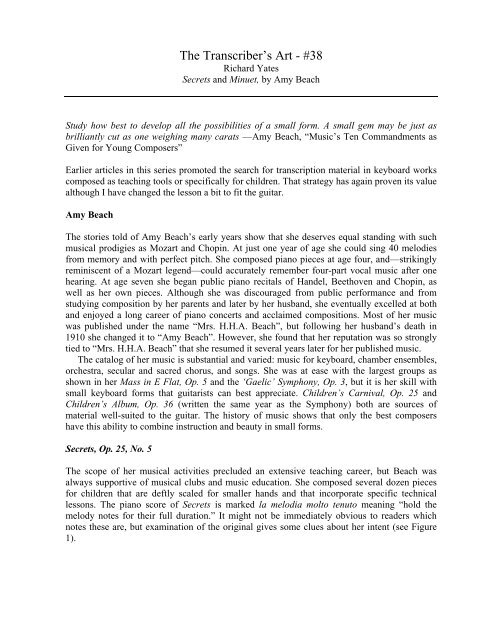


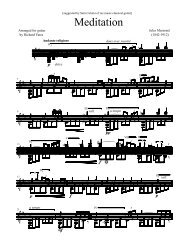
![Finale 2005b - [BWV846-Prelude in C.MUS]](https://img.yumpu.com/43978887/1/190x245/finale-2005b-bwv846-prelude-in-cmus.jpg?quality=85)
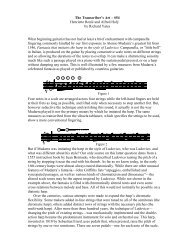
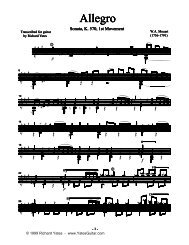
![Finale 2005b - [AirG-TAB.MUS] - Richard Yates Classical Guitar ...](https://img.yumpu.com/37104901/1/190x245/finale-2005b-airg-tabmus-richard-yates-classical-guitar-.jpg?quality=85)

